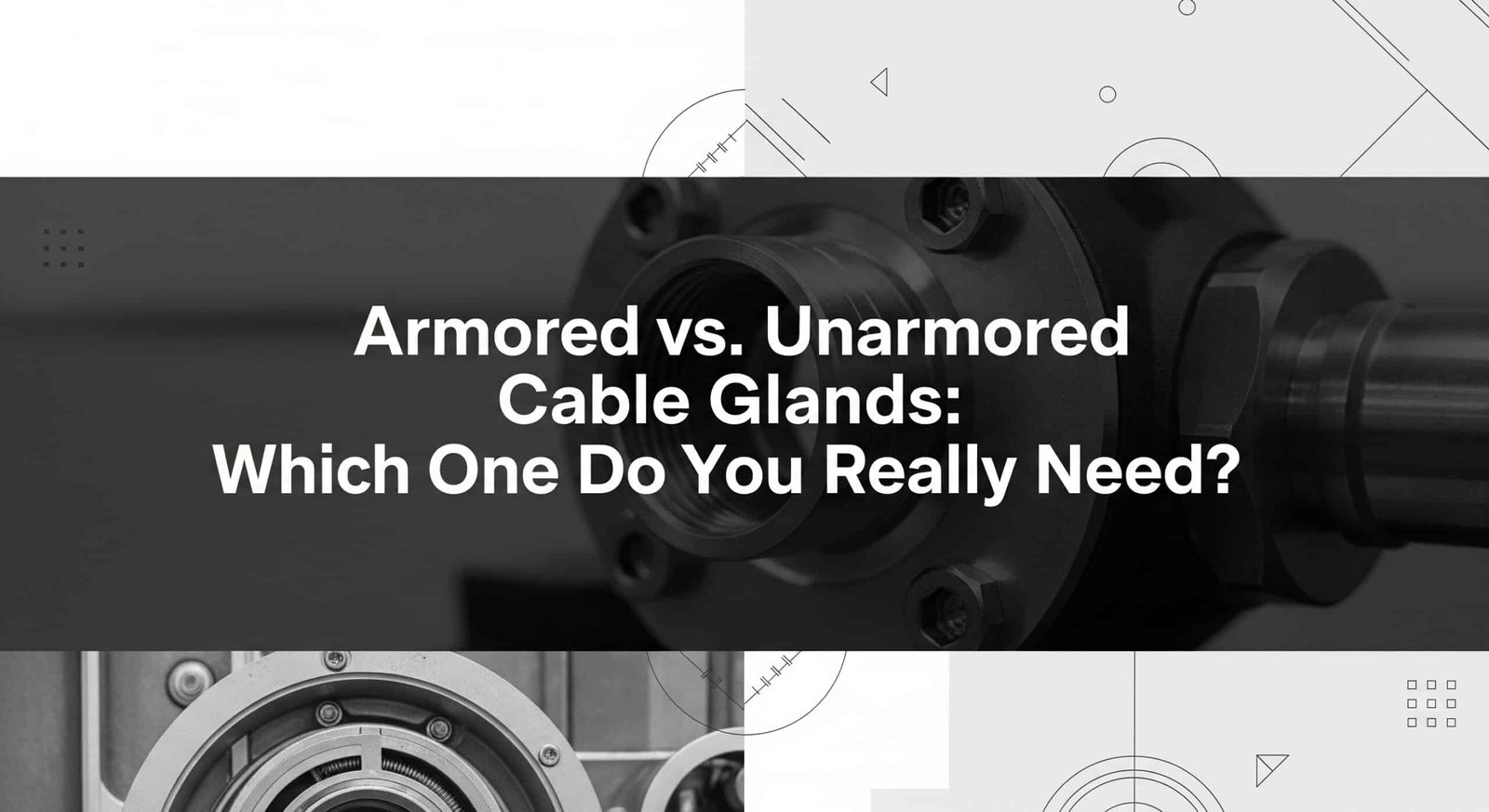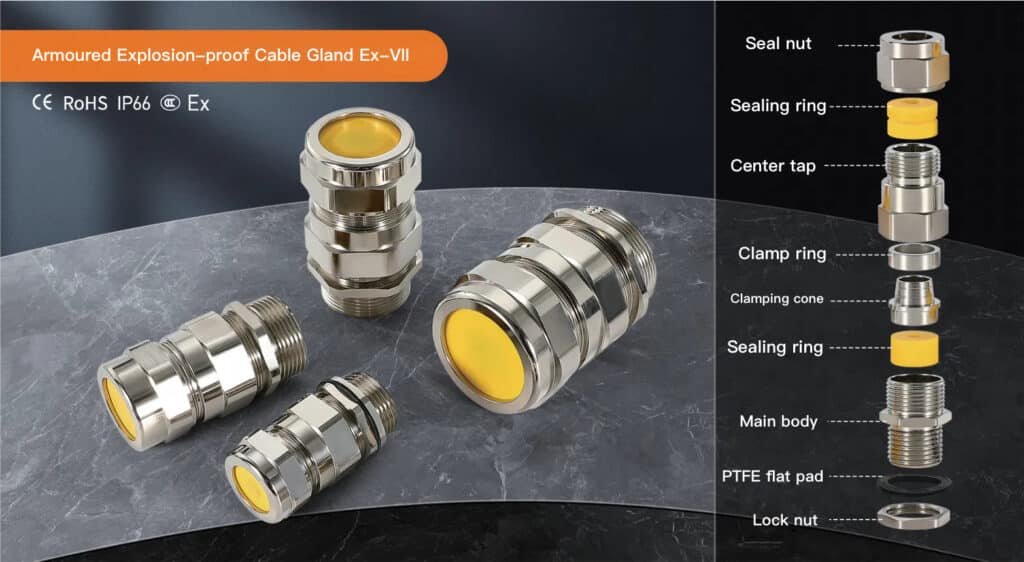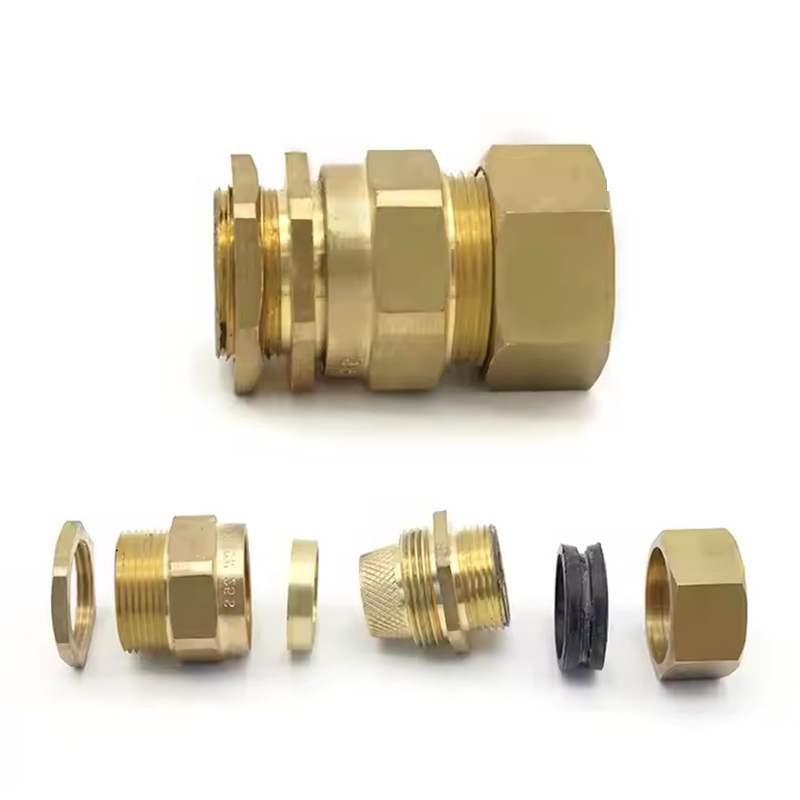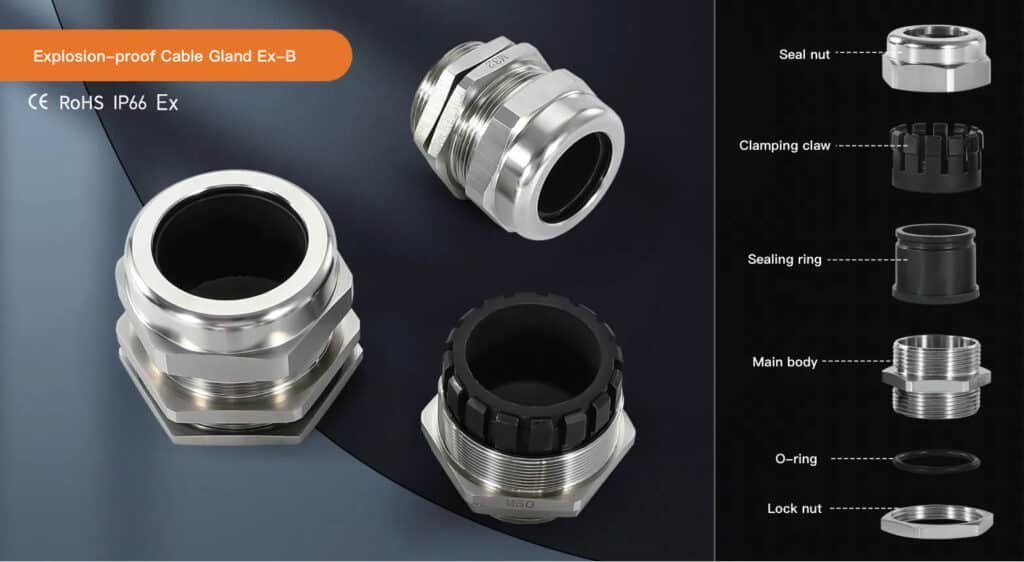Introduction
Staring at a cable gland specification sheet, feeling overwhelmed by the choice between armored and unarmored options? You’re not alone. Making the wrong choice here can cost you thousands in equipment damage, safety violations, and project delays. The frustration of discovering your cable protection failed during a critical operation is every engineer’s nightmare.
The choice between armored and unarmored cable glands depends on your specific application requirements: armored cable glands provide superior mechanical protection and EMI shielding for harsh environments, while unarmored glands offer cost-effective solutions for standard indoor applications with minimal physical stress and electromagnetic interference.
Just last month, David, a project manager at a petrochemical facility in Texas, called me in panic after discovering several cable failures in their new expansion. Despite choosing what seemed like adequate protection, the unarmored cable glands couldn’t handle the mechanical stress from vibrating equipment and corrosive environment. Let me walk you through the exact decision framework that prevents these costly mistakes.
Table of Contents
- What Are the Key Differences Between Armored and Unarmored Cable Glands?
- When Should You Choose Armored Cable Glands?
- What Applications Are Perfect for Unarmored Cable Glands?
- How Do Cost Factors Impact Your Decision?
- What Installation Differences Should You Consider?
- FAQs About Armored vs Unarmored Cable Glands
What Are the Key Differences Between Armored and Unarmored Cable Glands?
Understanding the fundamental differences between these two cable gland types is like knowing the difference between a tank and a sedan – both get you there, but one’s built for war zones.
Armored cable glands feature specialized clamping mechanisms for steel wire armor (SWA)1 or aluminum wire armor (AWA) cables, providing superior mechanical protection and EMI shielding2, while unarmored glands are designed for standard cables without metallic armor, offering simpler installation and lower cost for less demanding environments.
Construction Differences
Armored Cable Gland Components:
- Armor clamping cone – secures steel/aluminum wire armor
- Sealing ring – maintains IP rating around armor termination
- Earth tag connection – provides electrical continuity for armor
- Inner seal – protects against ingress around cable cores
- Strain relief – handles mechanical stress on armor and cores
Unarmored Cable Gland Components:
- Cable seal – single sealing element around cable sheath
- Compression nut – applies sealing pressure
- Body thread – standard metric or NPT threading
- Basic strain relief – limited mechanical protection
Hassan, who manages a chemical processing plant in Saudi Arabia, learned these differences the hard way. His initial installation used unarmored glands on armored cables, leaving the steel wire armor floating without proper termination. This created both safety hazards and EMI problems that cost $50,000 in equipment damage before we helped him upgrade to proper armored glands.
Performance Characteristics Comparison
| Feature | Armored Cable Glands | Unarmored Cable Glands |
|---|---|---|
| Mechanical Protection | Excellent (handles 500N+ pull force) | Basic (up to 100N pull force) |
| EMI Shielding | Superior (armor provides 360° shield) | Limited (depends on cable design) |
| IP Rating | IP66/IP67/IP68 achievable | IP65/IP66 typical maximum |
| Temperature Range | -40°C to +100°C+ | -20°C to +80°C typical |
| Chemical Resistance | Enhanced with proper materials | Standard polymer resistance |
| Installation Complexity | Higher (armor termination required) | Simple (plug-and-seal design) |
Material Considerations
Armored Gland Materials:
- 316L stainless steel – marine and chemical environments
- Nickel-plated brass – standard industrial applications
- Aluminum alloy – lightweight applications with armor compatibility
- Specialized coatings – ATEX compliance3 for hazardous areas
Unarmored Gland Materials:
- Nylon 66 – cost-effective indoor applications
- Brass – moderate environmental protection
- Stainless steel – corrosive environments without armor needs
- Polycarbonate – transparent housings for visual inspection
At Bepto, we manufacture both types with identical quality standards, but the material selection and internal mechanisms are optimized for their specific cable types and applications.
Cable Compatibility Requirements
Armored Cable Types:
- SWA (Steel Wire Armored) – most common industrial armored cable
- AWA (Aluminum Wire Armored) – lighter weight alternative
- STA (Steel Tape Armored) – flat tape armor construction
- DSTA (Double Steel Tape Armored) – enhanced protection levels
Unarmored Cable Types:
- PVC sheathed – standard building wire applications
- XLPE insulated – power distribution cables
- Control cables – instrumentation and automation
- Flexible cables – moving machinery applications
The key insight David’s Texas facility learned: you cannot effectively terminate armored cables with unarmored glands, but you can use armored glands on unarmored cables if the application justifies the additional cost.
When Should You Choose Armored Cable Glands?
Choosing armored cable glands for the wrong application is expensive overkill, but skipping them when you need them is like going to a gunfight with a water pistol.
Choose armored cable glands when your application involves steel wire armored (SWA) or aluminum wire armored (AWA) cables, requires superior mechanical protection against rodent damage or physical impact, needs enhanced EMI shielding, or operates in harsh environments with vibration, chemical exposure, or extreme temperatures.
Critical Application Scenarios
Heavy Industrial Environments:
Hassan’s chemical plant represents the perfect armored cable gland application:
Environmental Challenges:
- Corrosive chemicals requiring 316L stainless steel construction
- High vibration from rotating equipment and pumps
- Temperature extremes from -20°C to +85°C
- Mechanical hazards from maintenance activities and material handling
- EMI sources from variable frequency drives and welding operations
Solution Implemented:
- ATEX-certified armored glands for hazardous area compliance
- 316L stainless steel construction for chemical resistance
- IP68 rating for washdown and weather protection
- Proper armor termination for electrical safety and EMI control
Results Achieved:
- Zero cable failures over 24 months of operation
- Eliminated EMI issues that previously caused control system faults
- Reduced maintenance costs by 60% compared to previous installation
- Full regulatory compliance for safety and environmental standards
Mechanical Protection Requirements
High-Risk Scenarios:
- Underground installations – protection against excavation damage
- Rodent-prone areas – steel armor prevents gnawing damage
- High-traffic zones – impact protection from vehicles and equipment
- Outdoor installations – weather and UV protection requirements
- Vibrating equipment – mechanical stress from motors and pumps
Protection Levels Achieved:
- Crush resistance up to 1250N per IEC standards
- Impact protection against 5J impacts per IEC 622624
- Tensile strength handling 500N+ cable pull forces
- Bend radius protection maintaining cable integrity during installation
EMI Shielding Applications
Critical EMI Environments:
- Variable frequency drive installations – high-frequency switching noise
- Welding operations – broadband electromagnetic interference
- Radio transmitter facilities – high-power RF environments
- Medical equipment – sensitive instrumentation requiring clean power
- Data centers – preventing crosstalk between communication cables
David’s petrochemical facility discovered that proper armored cable gland installation eliminated 90% of their PLC communication errors, saving $180,000 annually in production losses.
Regulatory and Safety Requirements
Mandatory Armored Gland Applications:
- ATEX/IECEx zones – explosion-proof requirements for hazardous areas
- Marine installations – Lloyd’s Register and classification society requirements
- Nuclear facilities – radiation resistance and safety system compliance
- Oil and gas platforms – API and NORSOK standard5 compliance
- Railway systems – EN 50155 and fire safety requirements
What Applications Are Perfect for Unarmored Cable Glands?
Unarmored cable glands aren’t the budget option – they’re the right choice when your application doesn’t justify armored protection’s complexity and cost.
Unarmored cable glands excel in standard building installations, office environments, light industrial applications, and indoor control panels where cables face minimal mechanical stress, low EMI exposure, and standard environmental conditions, providing cost-effective sealing and strain relief for non-armored cables.
Ideal Application Environments
Commercial Building Systems:
- HVAC control panels – standard temperature and humidity conditions
- Lighting control systems – minimal mechanical stress environments
- Fire alarm installations – indoor protected environments
- Building automation – office and retail facility applications
- Elevator control systems – enclosed machine room installations
Light Industrial Applications:
Maria, a facilities manager at a food processing plant in California, chose unarmored glands for their packaging line control systems. The clean, indoor environment with standard PVC control cables made unarmored glands the perfect choice, saving 40% on installation costs while providing adequate protection.
Cost-Effective Solutions:
- Indoor control panels with IP54/IP65 protection requirements
- Standard PVC cables without armor requirements
- Low-vibration environments with minimal mechanical stress
- Temperature-controlled facilities within standard operating ranges
- Clean environments without chemical or corrosive exposure
Performance Advantages
Simplified Installation:
- Single-step sealing around cable outer sheath
- No armor termination required, reducing installation time
- Standard tools sufficient for installation and maintenance
- Fewer components reducing potential failure points
- Quick replacement for maintenance and modifications
Cost Benefits:
- Lower material costs – 50-70% less than equivalent armored glands
- Reduced installation time – 30-40% faster installation
- Standard inventory – common sizes readily available
- Simplified maintenance – fewer specialized components
- Lower training requirements – standard installation techniques
Material Selection for Unarmored Applications
Nylon 66 Cable Glands:
- Temperature range: -20°C to +80°C
- Chemical resistance: Good against oils, weak acids, alkalis
- UV resistance: Black grades suitable for outdoor use
- Cost advantage: Most economical option for standard applications
- Flame rating: UL94-V2 for electrical safety compliance
Brass Cable Glands:
- Temperature range: -40°C to +100°C
- Corrosion resistance: Nickel plating for enhanced protection
- Mechanical strength: Superior to nylon for demanding applications
- Electrical properties: Excellent conductivity for grounding
- Longevity: 15+ year service life in appropriate environments
Application-Specific Selection
Office Building Installations:
- Nylon glands for standard HVAC and lighting control
- IP54 rating sufficient for typical indoor environments
- Metric threading (M12, M16, M20) for European equipment
- UL listing for North American electrical code compliance
Food Processing Facilities:
Maria’s California plant uses our specialized food-grade selection:
- FDA-compliant materials for direct food contact areas
- Stainless steel construction for washdown environments
- IP65/IP66 ratings for cleaning and sanitization
- Temperature resistance for hot washdown procedures
- Smooth surfaces preventing bacterial growth
How Do Cost Factors Impact Your Decision?
Understanding the true cost of cable gland selection goes far beyond the initial purchase price – it’s about total cost of ownership over the system’s lifetime.
Cost analysis for cable gland selection must include initial purchase price, installation labor, maintenance requirements, failure costs, and regulatory compliance expenses, with armored glands typically costing 3-5x more initially but potentially saving money long-term in demanding applications through reduced failures and maintenance.
Initial Cost Comparison
Purchase Price Analysis:
| Gland Type | Size Range | Material | Unit Cost | Typical Application |
|---|---|---|---|---|
| Nylon Unarmored | M12-M50 | Nylon 66 | $2-15 | Indoor control panels |
| Brass Unarmored | M12-M50 | Nickel-plated brass | $8-35 | Standard industrial |
| Brass Armored | M20-M75 | Nickel-plated brass | $25-120 | SWA cable termination |
| SS Armored | M20-M75 | 316L stainless steel | $45-200 | Chemical/marine environments |
Hassan’s Saudi Arabia chemical plant initially balked at the 4x cost difference between unarmored nylon and armored stainless steel glands. However, our total cost analysis showed the armored glands would pay for themselves within 18 months through eliminated failures and reduced maintenance.
Installation Cost Factors
Labor Requirements:
- Unarmored installation: 15-20 minutes per gland (standard electrician)
- Armored installation: 30-45 minutes per gland (skilled technician required)
- Specialized tools: Armored glands may require armor cutting and termination tools
- Training costs: Additional training for proper armor termination techniques
Hidden Installation Costs:
- Cable preparation time – armored cables require precise armor cutting and folding
- Testing requirements – armored installations need continuity and insulation testing
- Documentation – enhanced record-keeping for safety and compliance
- Inspection time – more complex installations require detailed quality checks
Long-Term Operating Costs
Maintenance Requirements:
David’s Texas petrochemical facility tracked maintenance costs over three years:
Unarmored Glands (Original Installation):
- Replacement rate: 15% annually due to environmental degradation
- Maintenance calls: 24 per year for seal failures and loose connections
- Downtime cost: $45,000 annually from production interruptions
- Material costs: $8,000 annually for replacement glands and seals
Armored Glands (After Upgrade):
- Replacement rate: 2% annually, mostly due to mechanical damage
- Maintenance calls: 4 per year for routine inspections only
- Downtime cost: $3,000 annually from scheduled maintenance
- Material costs: $2,500 annually for minimal replacements
Three-Year ROI Calculation:
- Additional upfront investment: $35,000 for armored gland upgrade
- Annual savings: $47,500 in reduced maintenance and downtime
- Payback period: 8.8 months
- Three-year net savings: $107,500
Risk and Compliance Costs
Failure Cost Analysis:
- Equipment damage from water ingress or EMI: $10,000-500,000+
- Safety incidents from improper armor termination: Regulatory fines + liability
- Production losses from unplanned downtime: $1,000-50,000+ per hour
- Regulatory non-compliance penalties: $25,000-1,000,000+ depending on industry
Insurance Considerations:
- Premium reductions for proper cable protection in hazardous environments
- Liability coverage requirements for safety-critical applications
- Risk assessment impact on facility insurance ratings
- Compliance documentation requirements for policy maintenance
At Bepto, we help customers perform comprehensive cost-benefit analysis including all these factors, ensuring your cable gland investment delivers optimal value over the system’s entire lifecycle.
What Installation Differences Should You Consider?
Installation complexity can make or break your project timeline and budget – understanding these differences upfront prevents costly surprises and rework.
Armored cable gland installation requires specialized techniques for armor preparation, termination, and grounding, typically taking 2-3x longer than unarmored installations, while unarmored glands offer simple plug-and-seal installation but require careful attention to cable strain relief and environmental sealing for optimal performance.
Armored Cable Gland Installation Process
Step 1: Cable Preparation (Critical Phase)
- Measure and mark armor cutting point per manufacturer specifications
- Cut outer sheath cleanly without damaging armor wires
- Separate armor wires and fold back evenly around cable circumference
- Trim armor to length ensuring proper engagement with clamping cone
- Prepare inner cores by stripping to required lengths
Step 2: Gland Assembly
Hassan’s chemical plant installation team follows our systematic approach:
- Thread gland body into panel with proper thread sealant
- Install sealing components in correct sequence per manufacturer instructions
- Insert cable through gland ensuring armor wires align with clamping cone
- Position earth tag for proper electrical continuity with armor
- Apply specified torque to compression nut for optimal sealing
Step 3: Testing and Verification
- Continuity testing between armor and earth connection
- Insulation resistance testing per electrical safety standards
- Pull testing to verify mechanical integrity of armor termination
- IP rating verification through pressure or submersion testing
Unarmored Cable Gland Installation
Simplified Process:
Maria’s California food processing facility appreciates the straightforward unarmored installation:
Quick Installation Steps:
- Thread gland into panel with appropriate thread sealant
- Insert cable through compression nut and sealing elements
- Position cable for proper strain relief and sealing
- Tighten compression nut to manufacturer’s torque specification
- Verify sealing and strain relief adequacy
Quality Control Points:
- Cable diameter match with gland sealing range
- Proper insertion depth for optimal strain relief
- Even compression around cable circumference
- No damage to cable sheath during installation
Tool and Equipment Requirements
Armored Installation Tools:
- Armor cutting tools – specialized cable strippers for clean armor cuts
- Torque wrenches – calibrated tools for proper compression
- Continuity testers – verify electrical connections
- Cable pulling equipment – handle heavy armored cables safely
- Personal protective equipment – cut-resistant gloves for armor handling
Unarmored Installation Tools:
- Standard cable strippers for outer sheath preparation
- Basic hand tools – wrenches and screwdrivers
- Cable ties for strain relief and organization
- Multimeter for basic electrical verification
- Standard PPE for electrical work safety
Common Installation Mistakes
Armored Gland Errors:
David’s Texas facility initially experienced several installation problems:
- Improper armor cutting – jagged cuts causing poor termination
- Insufficient armor engagement – reduced mechanical protection
- Missing earth connections – safety hazards and EMI problems
- Over-tightening – damaged sealing elements and reduced performance
- Inadequate testing – undetected installation defects
Solutions Implemented:
- Comprehensive training for installation technicians
- Standardized procedures with step-by-step checklists
- Quality control inspections at each installation phase
- Proper tools and equipment for professional results
- Documentation requirements for traceability and compliance
Unarmored Gland Errors:
- Wrong size selection – inadequate sealing or cable damage
- Insufficient strain relief – mechanical stress on connections
- Poor surface preparation – compromised environmental sealing
- Inadequate torque – loose connections and ingress failures
- Missing thread sealant – water penetration through threads
Installation Time and Labor Costs
Comparative Installation Times:
| Installation Type | Preparation Time | Assembly Time | Testing Time | Total Time |
|---|---|---|---|---|
| Nylon Unarmored | 5 minutes | 8 minutes | 2 minutes | 15 minutes |
| Brass Unarmored | 6 minutes | 10 minutes | 4 minutes | 20 minutes |
| Brass Armored | 15 minutes | 20 minutes | 10 minutes | 45 minutes |
| SS Armored (ATEX) | 20 minutes | 25 minutes | 15 minutes | 60 minutes |
Labor Skill Requirements:
- Unarmored installations: Standard electrician capabilities
- Armored installations: Specialized training and certification recommended
- ATEX/Hazardous area: Additional safety training and certification required
- Quality control: Inspection and testing procedure training essential
This installation complexity difference significantly impacts project scheduling and labor budgets, making proper planning essential for successful project completion.
Conclusion
The choice between armored and unarmored cable glands isn’t about finding the “best” option – it’s about matching the right protection level to your specific application requirements and operating environment. From Hassan’s chemical plant success with armored glands eliminating costly failures to Maria’s food processing facility achieving optimal cost-effectiveness with unarmored solutions, the key is understanding your true needs. Remember that armored glands provide superior mechanical protection and EMI shielding for demanding environments, while unarmored glands offer cost-effective solutions for standard applications. Consider the total cost of ownership including installation, maintenance, and failure costs rather than just initial purchase price. At Bepto, we help customers navigate this decision through comprehensive application analysis, ensuring you get the right protection level at the best value. Whether you need basic nylon unarmored glands for indoor control panels or ATEX-certified stainless steel armored glands for hazardous chemical environments, proper selection and installation will protect your investment and ensure reliable long-term performance. 😉
FAQs About Armored vs Unarmored Cable Glands
Q: Can I use armored cable glands with unarmored cables?
A: Yes, you can use armored cable glands with unarmored cables, though it’s typically unnecessary and more expensive. The armor clamping components simply won’t engage, but the inner sealing system will still provide proper cable termination. This approach might be justified when planning future upgrades to armored cables.
Q: What’s the main reason armored cable glands cost so much more?
A: Armored cable glands cost 3-5x more due to specialized armor clamping mechanisms, earth bonding components, enhanced materials for harsh environments, and additional manufacturing complexity. The higher cost reflects the superior mechanical protection and EMI shielding capabilities required for demanding industrial applications.
Q: How do I know if my environment requires armored cable glands?
A: Choose armored glands if you have steel wire armored (SWA) cables, high vibration environments, risk of mechanical damage, corrosive conditions, EMI concerns, or regulatory requirements for hazardous areas. Standard indoor applications with PVC cables typically only need unarmored glands.
Q: What happens if I install the wrong type of cable gland?
A: Installing unarmored glands on armored cables leaves the steel armor ungrounded, creating safety hazards and EMI problems. Using armored glands unnecessarily wastes money but doesn’t harm performance. Always match the gland type to your cable construction for optimal safety and performance.
Q: Are there any hybrid options between armored and unarmored glands?
A: Some manufacturers offer “universal” glands that can accommodate both armored and unarmored cables, but these typically compromise performance for versatility. At Bepto, we recommend selecting the specific gland type optimized for your cable construction rather than using compromise solutions for critical applications.
-
Learn about the construction and applications of Steel Wire Armored (SWA) cables. ↩
-
Explore the fundamental principles of Electromagnetic Interference (EMI) and how shielding works to protect sensitive electronics. ↩
-
Read the official European Commission guidelines on the ATEX directive for equipment used in explosive atmospheres. ↩
-
Understand the IEC 62262 standard and the meaning of IK codes for impact protection ratings. ↩
-
Discover the purpose and scope of the NORSOK standards developed by the Norwegian petroleum industry. ↩





